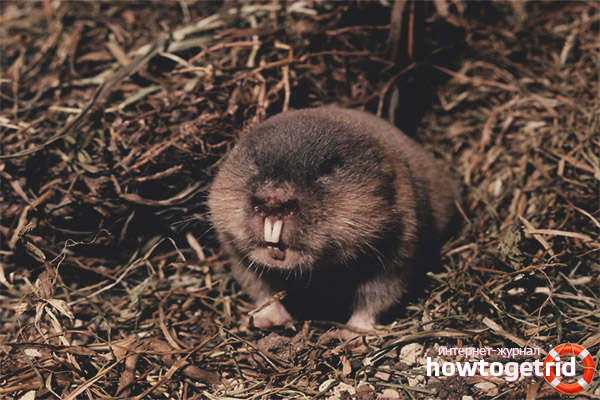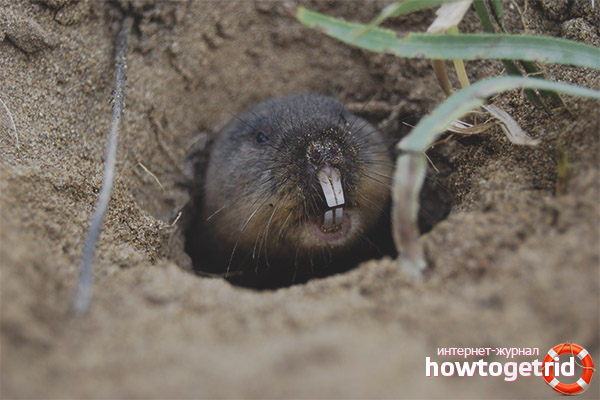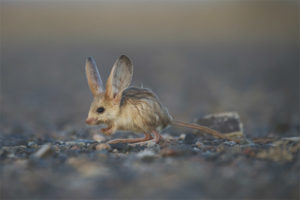The content of the article
The fauna of the earth is great, its representatives live everywhere - run around the earth, fly in the air, feel great in the water. The rodent squad also has many interesting representatives. We’ll talk about one of them, an animal called the common mole rat.
Description and appearance
The common mole rat belongs to the order of the hamsters, but this animal cannot be called a hamster - there are a lot of differences. Both external and lifestyle. Suffice it to say that the appearance of the animal is not quite ordinary. It seems to be similar to a rodent, but a specific rodent. So, the body is short - the length leaves only 11-13 centimeters, of which 1.5-2 centimeters fall on the share of a very short tail. The mass is also small - an adult animal weighs no more than 45 grams. Like many animals, there is also sexual dimorphism - males are usually larger than females. That is, it turns out - the females are even less weight and length.
The body is wedge-shaped, on a flat head, planted on a short neck, there are small convex black eyes, accustomed to night vision. In the dark, the beast sees and orientates perfectly. Another feature that distinguishes the mole vole from the brothers in the family is the complete absence of auricles. Nevertheless, with the hearing of this underground resident, everything is in order.
The body is completely covered with a short but dense soft fur of brown shades - on the back and sides it is dark, sometimes almost black, on the belly it is lighter - coffee and beige. The color of the fur differs in the place of residence of the animals - the closer to the north they live, the thicker and darker the color. Although it often happens that the animals living in the same area have different colors of fur
Another feature is the protruding teeth. With their help, the mole cat digs holes in which it usually lives. The only part of the body that is not covered with either fur or wool is pink legs with large claws.
Behavior
Animals live, as a rule, in small families (up to a dozen individuals), the composition of which may not change for several years. Usually a family consists of a pair of parents and children of one or two litters.
Rodents spend most of their lives in earthen burrows. This is not just minks, but a complicated and rather long (up to 80-100 meters) system of passages with many chambers - aft and nesting. Most of them go deep into the ground up to 4 meters. It turns out a kind of network of labyrinths from many corridors, most of which have no way out. Upstairs, animals are chosen very reluctantly and quite rarely. Usually this happens if for some reason the living space has ceased to be arranged and you need to move to a new place. And then, the move does not last very long - the animals usually settle near the old residence, not further than 800 meters.
Habitat
Due to the good adaptability of the body, the mole vole is able to live in different climatic conditions, so the distribution of the animal is very wide.The beast lives from the territory of Ukraine and Poland to northern China and Mongolia, inclusive. In the south, the habitat includes the countries of Central Asia (Uzbekistan, Turkmenistan, Tajikistan), the whole territory of Kazakhstan, part of Tuva, is inhabited by animals. The animal selects sections of the steppe, desert and semi-desert. It is desirable for a blindworm that the earth is soft and easy to dig. However, it often settles in a river floodplain on rocky shores, in salt marshes, and is even found in the mountains, reaching a height of about 4000 meters.
Breeding

The maturation of the mole vole is fast, and already in the second month of life, the animals reach puberty, ready for reproduction. Typically, the breeding season stretches for several months - it can start in March, and end in October - November. I must say that digging tunnels is in some way connected with the reproduction process - males thus make their way to the habitats of the females.
During the season, one female can be two, or even three times pregnant, giving birth to 2-5 cubs. Children develop quickly - after 21-23 days, their eyes open, on the 22nd - 25th day they can already eat on their own.
Nutrition
The basis of nutrition blindfolds are plant elements. Actively consumes the underground parts of plants - roots, bulbs, tubers. But do not pass by and aboveground parts. Worms, insects and larvae are eaten from animal food, which is good; it’s not difficult to catch them underground. Usually in the winter they try to make some supply of food - several kilograms of bulbs and roots, carefully prepared for a rainy day, lie in food chambers.
Benefit, harm
But this harm is insignificant, it cannot be called great. The mole vole is valued by man for loosening the soil, because of which it becomes rich in organic matter, thanks to the burrows of the beast, the fertile earth is saturated with oxygen and moisture.
The number of mole voles living on earth is variable. Often, a large number die because of the unfavorable climate - ferocious cold weather or water spills. Sometimes a population suffers due to an epidemic of some disease or parasites do not give the opportunity to develop and live. And sometimes vice versa - favorable weather conditions and an abundance of food provoke a large birth rate.
Video: common mole vole (Ellobius talpinus)










Submit